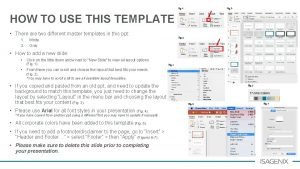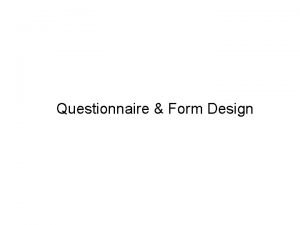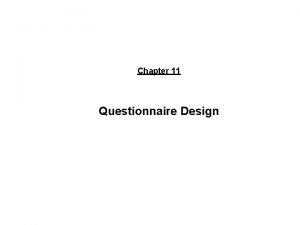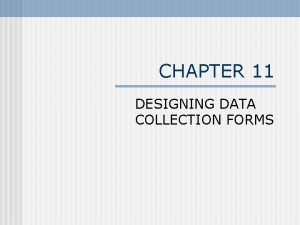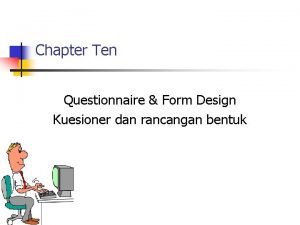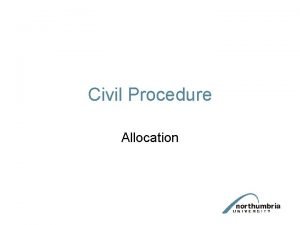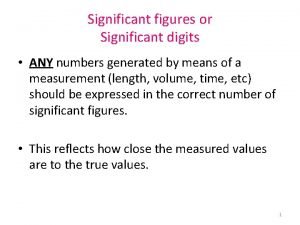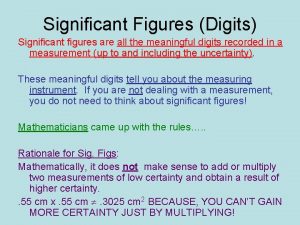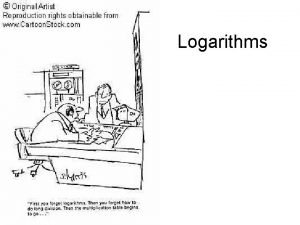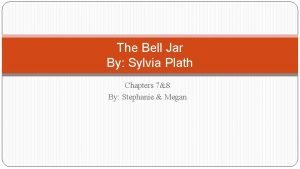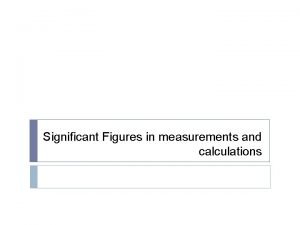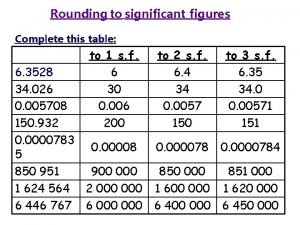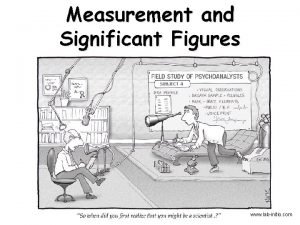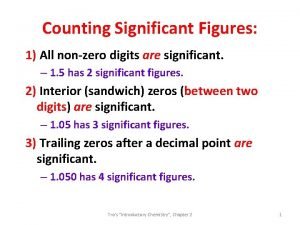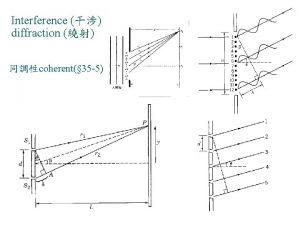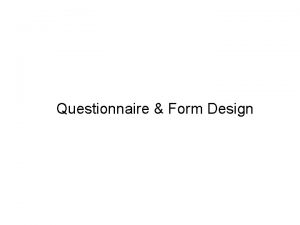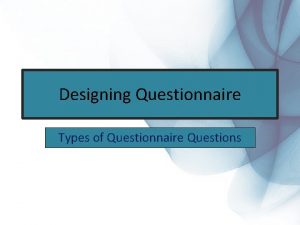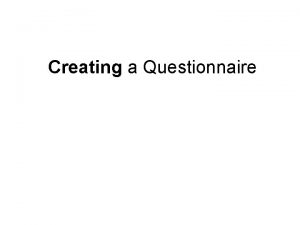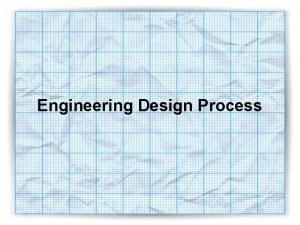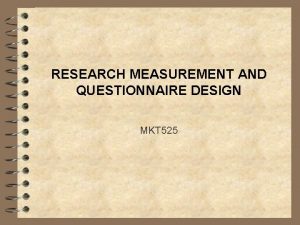Questionnaire Form Design Questionnaire Design Process Fig 10








































- Slides: 40

Questionnaire & Form Design

Questionnaire Design Process Fig. 10. 1 Specify the Information Needed Specify the Type of Interviewing Method Determine the Content of Individual Questions Design the Question to Overcome the Respondent’s Inability and Unwillingness to Answer Decide the Question Structure Determine the Question Wording Arrange the Questions in Proper Order Identify the Form and Layout Reproduce the Questionnaire Eliminate Bugs by Pre-testing

Effect of Interviewing Method on Questionnaire Design Department Store Project Mail Questionnaire • Please rank order the following department stores by picking out the store that you like most and assigning it a number 1. The second most preferred department store gets a number 2. Continue this procedure. The least preferred store should be assigned a rank of 10. No two stores should receive the same rank number. Store Rank Order 1. Parisian ______ 2. Macy's ______. . 10. Wal-Mart ______

Effect of Interviewing Method on Questionnaire Design Telephone Questionnaire • I will read to you the names of some department stores. Please rate them in terms of your preference. Use a ten-point scale, where 1 denotes not so preferred and 10 denotes greatly preferred. Again, please remember that the higher the number, the greater the degree of preference. Now, please tell me your preference to shop at. . . . (READ ONE STORE AT A TIME) Store Not So Greatly Preferred 1. Parisian 1 2 3 4 5 6 7 8 9 10 2. Macy's 1 2 3 4 5 6 7 8 9 10. . . 10. Wal-Mart 1 2 3 4 5 6 7 8 9 10

Effect of Interviewing Method on Questionnaire Design Personal Questionnaire • (HAND DEPARTMENT STORE CARDS TO THE RESPONDENT). Each store name written on a separate card. Please examine these cards carefully. (GIVE RESPONDENT TIME). Now, pull out that card which has the name of the store you like the most, (RECORD THE STORE NAME AND KEEP THIS CARD WITH YOU). Examine the remaining nine cards. What is your most preferred store? (REPEAT UNTIL RESPONDENT HAS ONLY ONE CARD LEFT) Store Rank Name of the Store 1. 1 _________ 2. 2 _________. 10 _________

Effect of Interviewing Method on Questionnaire Design Electronic Questionnaire • This question for e-mail and Internet questionnaires will be very similar to that for the mail questionnaire. • In all these methods, the questionnaire is self-administered by the respondent.

Individual Question Content ─ Are Several Questions Needed ? • Avoid double-barreled questions, because two or more questions are combined into one. Instead, two or more distinct questions should be asked:

Overcoming Inability To Answer – Is the Respondent Informed? • When not all respondents are informed about the topic, filter questions measuring familiarity and past experience should be asked before questions about the topics themselves. • A “don't know” option appears to reduce uninformed responses without reducing the response rate.

Overcoming Inability To Answer – Can the Respondent Remember? • Write the question in a way that does not tax the respondent’s memory too much • The following question will be difficult for people to answer: Q: In the past six months, have you experienced any nausea or dizziness?

Reasonable time frames • Use the right time frame for your question. Event Reasonable time frame Auto accident w/ injury Several years Hospital stay, car purchase One year Appliance purchase Three months Grocery purchase Two weeks Food consumption One day

Overcoming Inability To Answer – Can the Respondent Articulate? • Respondents may be unable to articulate certain types of responses, e. g. , describe the atmosphere of a department store. • Respondents should be given aids, such as pictures, maps, and descriptions to help them articulate their responses.

Overcoming Unwillingness To Answer Effort • If too much effort is required, people will not answer Context • Respondents are unwilling to respond to questions which they consider to be inappropriate for the given context. • The researcher should manipulate the context so that the request for information seems appropriate. Legitimate Purpose • Explaining why the data are needed legitimizes request and increase the respondents' willingness to answer. Sensitive Information • Respondents are unwilling to disclose, at least accurately, sensitive information because of embarrassment, loss of prestige or self-image.

Overcoming Unwillingness To Answer – Increasing the Willingness of Respondents • Place sensitive topics at the end of the questionnaire. • Preface the question with a statement that the behavior of interest is common. • Ask the question using the third-person technique: phrase the question as if it referred to other people. • Hide the question in a group of other questions which respondents are willing to answer. • Provide response categories rather than asking for specific figures. • Use randomized techniques.

Choosing Question Structure – Unstructured Questions • Unstructured questions are openended questions that respondents answer in their own words. What is your occupation? Who is your favorite actor? What do you think about people who shop at high-end department stores?

Choosing Question Structure – Structured Questions • Structured questions specify the set of response alternatives and the response format. A structured question may be multiple-choice, dichotomous, or a scale.

Choosing Question Structure – Multiple-Choice Questions • Example of multiple-choice question Do you intend to buy a new car within the next six months? ____ Definitely will not buy ____ Probably will not buy ____ Undecided ____ Probably will buy ____ Definitely will buy ____ Other (please specify)

Choosing Question Structure – Dichotomous Questions • A dichotomous question has only two response alternatives: yes or no, agree or disagree, and so on. • Often, the two alternatives of interest are supplemented by a neutral alternative, such as “no opinion, ” “don't know, ” “both, ” or “none. ” Do you intend to buy a new car within the next six months? _____ Yes _____ No _____ Don't know

Choosing Question Structure – Scales • Example of a Scale: Do you intend to buy a new car within the next six months? Definitely will not buy 1 Probably will not buy 2 Undecided 3 Probably will buy 4 Definitely will buy 5

Choosing Question Wording • Define the issue -Define the issue in terms of who, what, when, where, why, and way (the six Ws). Who, what, when, and where are particularly important. • Use ordinary words -Avoid the use of technical terms • Use unambiguous words -Avoid words that are likely to have different meanings for different people • Avoid leading or biasing questions

Choosing Question Wording • Avoid implicit alternatives - An alternative that is not explicitly expressed in the options is an implicit alternative. • Avoid implicit assumptions - Questions should not be worded so that the answer is dependent upon implicit assumptions about what will happen as a consequence. • Avoid Generalizations and Estimates • Dual Statements: Positive and Negative - Questions that are in the form of statements should be worded both positively and negatively

Determining the Order of Questions Opening Questions • The opening questions should be interesting, simple, and non-threatening. Type of Information • As a general guideline, basic information should be obtained first, followed by classification, and, finally, identification information. Difficult Questions • Difficult questions or questions which are sensitive, embarrassing, complex, or dull, should be placed late in the sequence.

Determining the Order of Questions Effect on Subsequent Questions • General questions should precede the specific questions (funnel approach). Q 1: “What considerations are important to you in selecting a department store? ” Q 2: “In selecting a department store, how important is convenience of location? ” (Correct)

Determining the Order of Questions Logical Order The following guidelines should be followed for branching questions: • The question being branched (the one to which the respondent is being directed) should be placed as close as possible to the question causing the branching. • The branching questions should be ordered so that the respondents cannot anticipate what additional information will be required.

Flow Chart for Questionnaire Design Fig. 10. 2 Introduction Ownership of Store, Bank, and Other Charge Cards Purchased Products in a Specific Department Store during the Last Two Months Yes How was Payment made? Credit Cash Other No Ever Purchased in a Department Store? Yes No Store Charge Card Bank Charge Card Other Charge Card Intentions to Use Store, Bank, and other Charge Cards

Form and Layout • Divide a questionnaire into several parts. • The questions in each part should be numbered, particularly when branching questions are used. • The questionnaires should preferably be precoded. • The questionnaires themselves should be numbered serially.

Example of a Precoded Questionnaire The American Lawyer A Confidential Survey of Our Subscribers (Please ignore the numbers alongside the answers. They are only to help us in data processing. ) 1. Considering all the times you pick it up, about how much time, in total, do you spend reading or looking through a typical issue of THE AMERICAN LAWYER? Less than 30 minutes. . . . . -1 11/2 hours to 1 hour 59 minutes. . -4 30 to 59 minutes. . . . -2 2 hours to 2 hours 59 minutes. . . -5 1 hour to 1 hour 29 minutes. . -3 3 hours or more. . . . -6

Reproduction of the Questionnaire • The questionnaire should be reproduced on good-quality paper and have a professional appearance. • Questionnaires should take the form of a booklet rather than a number of sheets of paper clipped or stapled together. • Vertical response columns should be used for individual questions. • Grids are useful when there a number of related questions they use the same set of response categories. • The tendency to crowd questions together to make the questionnaire look shorter should be avoided. • Directions or instructions for individual questions should be placed as close to the questions as possible.

Pretesting refers to the testing of the questionnaire on a small sample of respondents to identify and eliminate potential problems. • A questionnaire should not be used in the field survey without adequate pretesting. • All aspects of the questionnaire should be tested, including question content, wording, sequence, form and layout, question difficulty, and instructions. • The respondents for the pretest and for the actual survey should be drawn from the same population. • Pretests are best done by personal interviews, even if the actual survey is to be conducted by mail, telephone, or electronic means, because interviewers can observe respondents' reactions and attitudes.

Pretesting • After the necessary changes have been made, another pretest could be conducted by mail, telephone, or electronic means if those methods are to be used in the actual survey. • A variety of interviewers should be used for pretests. • The pretest sample size varies from 15 to 30 respondents for each wave. • Protocol analysis and debriefing are two commonly used procedures in pretesting. • Finally, the responses obtained from the pretest should be coded analyzed.

Questionnaire Design Checklist Table 10. 1 Step 1. Specify The Information Needed Step 2. Type of Interviewing Method Step 3. Individual Question Content Step 4. Overcome Inability and Unwillingness to Answer Step 5. Choose Question Structure Step 6. Choose Question Wording Step 7. Determine the Order of Questions Step 8. Form and Layout Step 9. Reproduce the Questionnaire Step 10. Pretest

Questionnaire Design Checklist Table 10. 1, cont. Step 1. Specify the Information Needed 1. Ensure that the information obtained fully addresses all the components of the problem. Review components of the problem and the approach, particularly the research questions, hypotheses, and specification of information needed. 2. Prepare a set of dummy tables. 3. Have a clear idea of the target population. Step 2. Type of Interviewing Method 1. Review the type of interviewing method determined based on considerations discussed in Chapter 6.

Questionnaire Design Checklist Table 10. 1, cont. Step 3. Individual Question Content 1. Is the question necessary? 2. Are several questions needed instead of one to obtain the required information in an unambiguous manner? 3. Do not use double-barreled questions.

Questionnaire Design Checklist Table 10. 1, cont. Step 4. Overcoming Inability and Unwillingness to Answer 1. Is the respondent informed? 2. If respondents are not likely to be informed, filter questions that measure familiarity, product use, and past experience should be asked before questions about the topics themselves. 3. Can the respondent remember? 4. Avoid errors of omission, telescoping, and creation. 5. Questions which do not provide the respondent with cues can underestimate the actual occurrence of an event. 6. Can the respondent articulate?

Questionnaire Design Checklist Table 10. 1, cont. Step 4. Overcoming Inability and Unwillingness to Answer 7. Minimize the effort required of the respondents. 8. Is the context in which the questions are asked appropriate? 9. Make the request for information seem legitimate. 10. If the information is sensitive: a. Place sensitive topics at the end of the questionnaire. b. Preface the question with a statement that the behavior of interest is common. c. Ask the question using the third-person technique. d. Hide the question in a group of other questions which respondents are willing to answer. e. Provide response categories rather than asking for specific figures. f. Use randomized techniques, if appropriate.

Questionnaire Design Checklist Table 10. 1, cont. Step 5. Choosing Question Structure 1. Open-ended questions are useful in exploratory research and as opening questions. 2. Use structured questions whenever possible. 3. In multiple-choice questions, the response alternatives should include the set of all possible choices and should be mutually exclusive. 4. In a dichotomous question, if a substantial proportion of the respondents can be expected to be neutral, include a neutral alternative. 5. Consider the use of the split ballot technique to reduce order bias in dichotomous and multiple-choice questions. 6. If the response alternatives are numerous, consider using more than one question to reduce the information processing demands on the respondents.

Questionnaire Design Checklist Table 10. 1, cont. Step 6. Choosing Question Wording 1. Define the issue in terms of who, what, when, where, why, and way (the six Ws). 2. Use ordinary words. Words should match the vocabulary level of the respondents. 3. Avoid ambiguous words: usually, normally, frequently, often, regularly, occasionally, sometimes, etc. 4. Avoid leading questions that clue the respondent to what the answer should be. 5. Avoid implicit alternatives that are not explicitly expressed in the options. 6. Avoid implicit assumptions. 7. Respondent should not have to make generalizations or compute estimates. 8. Use positive and negative statements.

Questionnaire Design Checklist Table 10. 1, cont. Step 7. Determine the Order of Questions 1. The opening questions should be interesting, simple, and nonthreatening. 2. Qualifying questions should serve as the opening questions. 3. Basic information should be obtained first, followed by classification, and, finally, identification information. 4. Difficult, sensitive, or complex questions should be placed late in the sequence. 5. General questions should precede the specific questions. 6. Questions should be asked in a logical order. 7. Branching questions should be designed carefully to cover all possible contingencies. 8. The question being branched should be placed as close as possible to the question causing the branching, and (2) the branching questions should be ordered so that the respondents cannot anticipate what additional information will be required.

Questionnaire Design Checklist Table 10. 1, cont. Step 8. Form and Layout 1. Divide a questionnaire into several parts. 2. Questions in each part should be numbered. 3. The questionnaire should be pre-coded. 4. The questionnaires themselves should be numbered serially.

Questionnaire Design Checklist Table 10. 1, cont. Step 9. Reproduction of the Questionnaire 1. The questionnaire should have a professional appearance. 2. Booklet format should be used for long questionnaires. 3. Each question should be reproduced on a single page (or double-page spread). 4. Vertical response columns should be used. 5. Grids are useful when there a number of related questions which use the same set of response categories. 6. The tendency to crowd questions to make the questionnaire look shorter should be avoided. 7. Directions or instructions for individual questions should be placed as close to the questions as possible.

Questionnaire Design Checklist Table 10. 1, cont. Step 10. Pretesting 1. Pretesting should be done always. 2. All aspects of the questionnaire should be tested, including question content, wording, sequence, form and layout, question difficulty, and instructions. 3. The respondents in the pretest should be similar to those who will be included in the actual survey. 4. Begin the pretest by using personal interviews. 5. Pretest should also be conducted by mail or telephone if those methods are to be used in the actual survey. 6. A variety of interviewers should be used for pretests. 7. The pretest sample size is small, varying from 15 to 30 respondents for the initial testing. 8. Use protocol analysis and debriefing to identify problems. 9. After each significant revision of the questionnaire, another pretest should be conducted, using a different sample of respondents. 10. The responses obtained from the pretest should be coded analyzed.
 Kathy coover
Kathy coover Processfig
Processfig Questionnaire design process chpt 11
Questionnaire design process chpt 11 Questionnaire design process chpt 11
Questionnaire design process chpt 11 Questionnaire form and design
Questionnaire form and design Allocation questionnaire
Allocation questionnaire Present continuous affirmative sentences
Present continuous affirmative sentences Sug figs
Sug figs Beam loaded as shown in fig. p-428
Beam loaded as shown in fig. p-428 Significant figures
Significant figures Significant figures definition
Significant figures definition Significant figures conversion
Significant figures conversion Sig fig rules for logs
Sig fig rules for logs Scientific notation rules
Scientific notation rules How to round sig figs when multiplying
How to round sig figs when multiplying Sig fig rules
Sig fig rules Redox reactions definition
Redox reactions definition Serving per container
Serving per container Ph sig figs
Ph sig figs Archegonium
Archegonium Why did jesus cursed the fig tree
Why did jesus cursed the fig tree Jesus and fig tree
Jesus and fig tree End times wood
End times wood The bell jar symbols
The bell jar symbols Sig figs game
Sig figs game 150 sig figs
150 sig figs Sig fig table
Sig fig table Sig fig
Sig fig Accurate vs reliable
Accurate vs reliable Fig organisasi
Fig organisasi Canyon tree frog
Canyon tree frog 52
52 Fig 42
Fig 42 Dorsal hollow nerve cord
Dorsal hollow nerve cord Fig 16
Fig 16 Sig fig rules
Sig fig rules Fig 31
Fig 31 Pigmented layer and neural layer
Pigmented layer and neural layer Sigfig rules
Sigfig rules Sig fig prefixes
Sig fig prefixes Fig
Fig
